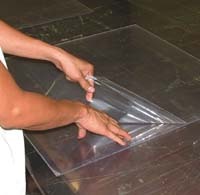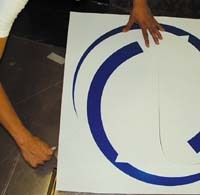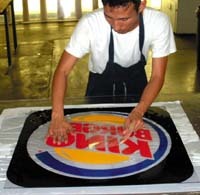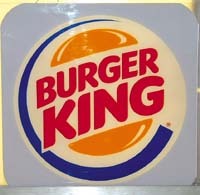Last month, Jim discussed basic properties of rigid plastics, thermoforming basics, the advantages of wet applications for vinyl-on-plastic jobs and general tips for integrating vinyl and acrylic.
Polycarbonate’s (PC) advantage is its great strength. It withstands wind and abrasion much better than acrylic. Understandably, that advantage also carries a higher price tag.
PC’s drawback is its tendency to yellow and degrade under UV light. However, plastics chemists have improved PC topcoatings, which has helped remedy the problem.
PCs absorb, and then outgas, moisture. Manufacturers often recommend drying PC in an air-recirculating batch oven for at least one hour prior to thermoforming or graphic application. This procedure helps remove the sheet’s internal moisture. Vinyl applied over insufficiently dried PC will trap outgassed moisture, which causes bubbles.
After drying, prep the surface with water and a mild, nonabrasive cleaner. Because the PC is softer than most plastics, it’s susceptible to scratching, so clean it carefully. Don’t use any solvents — although PC is strong, it’s susceptible to subsequent stress-induced cracking. Avoid using brushes, squeegees or other cleaning devices that could scratch the sheet’s surface. After washing the surface, rinse with clean water and dry with a soft cloth to prevent water spotting.
Having prepared the surface, install graphics using commercial application fluid. Washing the surface and using application fluid after drying the sheet may not make sense, but don’t worry. Neither washing nor wet application will compromise PC sheet.
Polystyrene
Polystyrene is a cost-effective option for interior retail signage and promotional displays. It’s also a popular screenprinting substrate, because it’s smooth and printable with various inks. Unlike polypropylene and polyester, no surface treatment, topcoating or special preparation is necessary before printing.
Styrene outgasses, and summer heat can exacerbate this condition. In many cases, outgassing breathes through permeable film.
A more complex styrene formulation, polystyrene is more stable and less prone to outgassing. Nevertheless, it won’t work outdoors. I investigated a vinyl-graphic failure several years ago where styrene was the substrate. The sign was mounted inside a bus-shelter enclosure with southern exposure. As heat built in the tight confines, the sign cooked and formed gigantic bubbles in the applied graphics.
There’s only one reason anyone would use polystyrene outdoors: It’s cheap. The cost of replacing the sign once it’s abused by outdoor conditions won’t make using polystyrene worth your time or money. Avoid it altogether for exterior signage.
Corrugated plastic board
Corrugated plastic boards, such as Coroplast


 Tip Sheet1 week ago
Tip Sheet1 week ago
 Photo Gallery3 days ago
Photo Gallery3 days ago
 Ask Signs of the Times5 days ago
Ask Signs of the Times5 days ago
 Real Deal2 weeks ago
Real Deal2 weeks ago
 Benchmarks1 week ago
Benchmarks1 week ago
 Photo Gallery7 hours ago
Photo Gallery7 hours ago
 Women in Signs2 weeks ago
Women in Signs2 weeks ago
 Women in Signs1 week ago
Women in Signs1 week ago






















